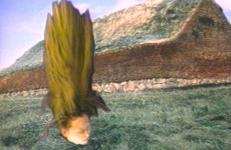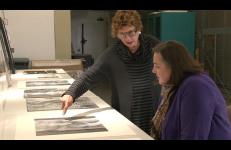
This section of the On Art and Artists collection highlights a number of experimental portraits of artists, and documentaries about the artistic process, from intimate one-on-one close-ups and dialogues, to full studio production studies. These works do not follow a traditional interview format, but are often intended as artworks in their own right. The artists and makers of these Artist Portraits draw artistic inspiration and stylistic license from the collaborators and interlocutors they depict.
Public Discourse is an in-depth study of illegal installation art. The primary focus is on the painting of street signs, advertising manipulation, metal welding, postering and guerrilla art, all performed illegally. Public Discourse is about passionate artists who want their work to be seen by a wide range of people rather than be confined to the systemic structures of galleries and museums.
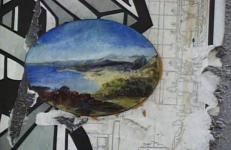
Brad Downey
Public Discourse, 2003
Public Discourse is an in-depth study of illegal installation art. The primary focus is on the painting of street signs, advertising manipulation, metal welding, postering and guerrilla art, all performed illegally. Public Discourse is about passionate artists who want their work to be seen by a wide range of people rather than be confined to the systemic structures of galleries and museums.

Public Discourse is an in-depth study of illegal installation art. The primary focus is on the painting of street signs, advertising manipulation, metal welding, postering and guerrilla art, all performed illegally. Public Discourse is about passionate artists who want their work to be seen by a wide range of people rather than be confined to the systemic structures of galleries and museums.

Freed documents artist James Rosenquist at home in an East Hampton, N.Y studio in March 1972. Rosenquist and his collaborators work on a project entitled 47 Dirty Band Aids with blaring music dominating the environment while they paint. Somewhat ironically Rosenquist describes each colour for the black and white video as he applies it to a large panel. With the camera roaming between the two of them Freed interrogates Rosenquist in a quieter moment, probing him for the intentions and ultimate destination of his work.
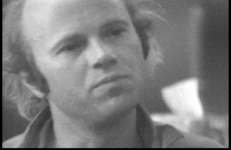
Sadie Curtis (1931-2012) was a Navajo woman descended from five generations of weavers. Filmed inside her hogan, Sadie talks about learning to weave as a child and how she gained fame from the creation of an American flag in the Navajo style.
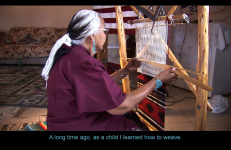
Flesh meets robotics in this early video documentation of Survival Research Laboratory’s spectacular exhibitions of collective invention, anti-corporate technology, and satirical mass destruction. In the performances documented here, various animal corpses are integrated into the action as the clawed and spiked machines attack dummies, each other, and, occasionally, the audience. The video begins with the song Stairwell to Hell, an appropriate prologue.
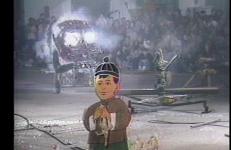
Cindy Sherman received an MFA from the State University of New York at Buffalo in 1976, where she studied photography. During this time she was also involved with HallWalls, an alternative gallery space in Buffalo. She is best known for her black and white Untitled Film Stills, which she made in the late 70s and early 80s. In carefully designed settings, Sherman placed herself, using costumes, wigs, and makeup, in various scenarios suggetive of B-movies from the 1950s.

This tape profiles mother and daughter artists Betye and Alison Saar. Both artists work with sculpture and installation, frequently using found objects, wood, and sheet metal to evoke sacred African-American rituals and images. Similar Differences was produced in concert with their first collaborative exhibition in a decade, Secrets, Dialogues, Revelations, which opened at UCLA’s Wight Gallery in January 1990 and toured nationally in 1992.
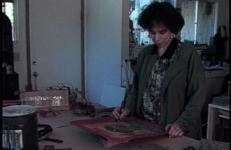
Laurie Simmons’s photographs are brought to life in Laurie Simmons: A Teaser, MICA-TV’s portrait of the acclaimed photographer. In the early 1980s, Simmons focused on underwater photographs of women, which suggested the stylized tableaux of Esther Williams’s water ballets. Taping through a glass window in the bottom of a swimming pool, Michael Owen and Carole Ann Klonarides recorded Simmons while she was shooting her models.
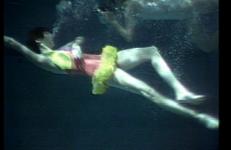
For the past 20 years Alexis Smith's mixed media work has explored primal American myths: the open road, the bad/good guy/gal, the quest for romance, and the search for paradise. This portrait of the artist explores the roots of her thought and work, and was produced in conjunction with her exhibition at the Whitney Museum of American Art, held in November 1991.
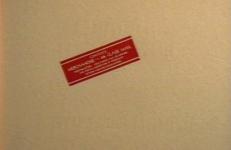
Shot in Naples, Vienna, and New York, Some Chance Operations explores the notion of an archival form, in this instance film, as an unstable memory receptacle that can vanish. History and how it is made is meditated upon as one of many chance operations. The filmmaker Elvira Notari, who had a film production company in Naples from 1906 to 1930, plays a significant role as an impetus for Some Chance Operations. Despite the fact that she was a prolific filmmaker, producing over sixty feature films, only three remain intact.
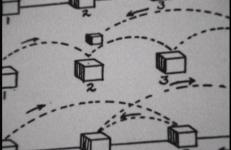
“We lose good artists to the past all the time because their work was ephemeral, or difficult, or fashion wasn’t on their side. The performance artist Stuart Sherman, who died of AIDS in 2001, was a candidate for disappearance on all three counts.”
— New York Times, 2009
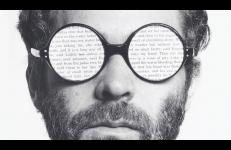
Sphinxes Without Secrets is an energetic and transgressive acount of outstanding female performance artists, and an invaluable document of feminist avant-garde work of the 70s and 80s. No Mona Lisa smiles here, as performance artists spill their guts about what outrages and delights them. Performers, curators, and critics unravel the mysteries of a new art form and ponder the world women confront today. Since its inception, performance art has provided a forum for artists who create work that challenges the dominant aesthetic and cultural status quo.
